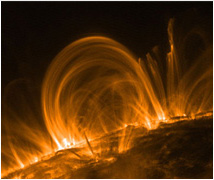|
|

|
These solar flares and coronal mass ejections occur relatively rapidly causing the Sun to shine brighter across the whole electromagnetic spectrum. Charged particles of immense energies are produced and are, on occasion, sent hurtling towards the Earth!
|
|
| |
The Sun is a mass of fiery stone, a little larger than Greece.
- Anaxagoras 434 BC |
Although the Sun is very close compared to other stars, it is still 150 million kilometers away. This means that we still have to use telescopes to see it in any detail. Even with the best telescopes we can build, the smallest object we can see on the Sun has to be at least 70 km on a side (about the size of Yosemite National Park) and most times we can't see anything smaller than 300-1000 km on a side (about the size of Montana). In today's topic we will explore The Sun Close-Up.
Although the Sun is far bigger in the sky than any other star, it is still 150 million kilometers away. This means that we can't simply stick a thermometer into its atmosphere and measure the temperature. All of our information about the Sun comes from observations of the radiation it emits. We use our understanding of physics to deduce how the Sun produces this radiation. These observations can tell us a lot about the Sun: how hot the atmosphere is, how dense it is, how fast it is moving. Modern space-based instrumentation can even allow us to learn about the inside of the Sun by observing disturbances on the surface of the Sun (much like we use earthquake information to learn about the inside of the Earth).
The biggest problem we have with the Sun being so far away is that it is hard to study it in detail. You have to build a pretty big pair of glasses to see that far. Fortunately, that's exactly what we do. We build big telescopes on the Earth and in space to observe as much detail of the Sun as we can. Even with our best telescopes we can only see objects on the Sun which are at least 70 km across, and most of our telescopes can only see objects bigger than 350-1000 km across. Doesn't sound very impressive. However, this is equivalent to reading the date on a penny from 9 km away, so it isn't too bad!
Links